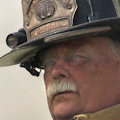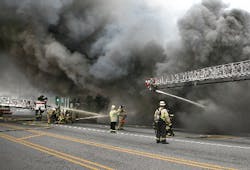Sometimes, a fireground picture is worth a thousand words
Many fireground photos pass through my screen over the course of a week, and a set that hit here yesterday really caught my eye.
Chicago fireground photographer Hank Sajovic happened to catch an amazing sequence of fire progression photos right after he arrived on the scene of what eventually progressed to a second alarm (2-11 in the Chicago area) in Oak Lawn, IL.
The photos are especially instructional as they show an attack going from offensive to defensive and in the process, responding apparatus were spotted in positions that allowed them to fully utilize their capabilities.
The full set of photos is posted here.
Here’s what they show.
It appears that the fire got into the cockloft and rapidly spread laterally—judging by the smoke, my bet is that it was there before the first line was charged.
The commander immediately shut down the 4-lane highway that runs in front of the strip of stores, and you can see that one of the first arriving tower ladder companies, was positioned across the street. Good move here.
At some point early in the operation, it appears that the commander had to make a decision to either commit people to a two-position roof vent operation to help stop the lateral spread of the fire or to use the heavy stream capabilities of the ladder companies.
The best practice would be to do both if you had enough companies.
Hank said that TICs showed heavy throughout the overhead and because all extra alarm companies were coming from mutual aid departments, the decision to get big water on the rapidly spreading fire as quickly as possible, was a first priority.
By positioning the first arriving tower ladder across the street, the members has full horizontal access to the strip of stores from ground level. If the rig was placed any closer, the basket may not have reached the ground, relegating the unit’s use to squirting water in the fire’s self-vent roof holes— good looking on the Ten o’clock news not a very effective tactic in stopping lateral spread.
The heavy stream from Chicago Ridge’s tower ladder and Roberts Park’s ladder seems to have quickly knocked down the fire. What’s unusual is that fighting the traditional instinct to raise them high in the air, the officers decided to use them to great advantage from ground level.
And finally, looking at the photos, we can see that the aerial devices had full access to the front of the building. Where are the engines? In the Chicago area, reverse lays, from the fire to the hydrant, are the norm, and at this fire the practice proved that having the engines positioned at the water source rather than blocking the front of the building, tethered to the end of an LDH umbilical cord, was key to the ladder streams’ effectiveness.
While a forward lay works fine for most fires, the wisdom of having the engines tied directly into hydrants and pumping back through lines to the fire scene at large commercial fires is, in some areas, becoming a lost art.
Take a close look at the photos to prove otherwise.
About the Author

Capt. Dave Fornell
Captain David P. Fornell is active as a line officer in the Casstown Community Fire Department, Casstown, OH, protecting 88 square miles of rural area in and around Casstown, Ohio. He formerly held the rank of Captain of the Beckerle & Company, Hose Company, Engine #9 of the Danbury, Connecticut fire department protecting a busy city of 85,000, and was the full time Chief of the Westchester, Illinois fire department, a suburb of Chicago. He started his career as a firefighter in the Addison, IL Fire Department, located about 20 miles west of Chicago. Capt. Fornell is a certified fire service instructor specializing in engine company operations, company officer development and fire ground safety courses and he holds the rank of Honorary Battalion Chief of the FDNY. He is the author of "FIRE STREAM MANAGEMENT HANDBOOK" along with an accompanying training video published by Fire Engineering Books and Videos, and served seven years as the Executive Editor of FIRE APPARATUS magazine. Capt. Fornell has written articles for FIRE ENGINEERING and FIREHOUSE magazines in the U.S., FIRE AND RESCUE and MILITARY FIREFIGHTER in the United Kingdom. He has hosted the rural water supply, engine company operations and line officer training segments of "THE FIRST LINE SUPERVISOR" for the FETN television network.
